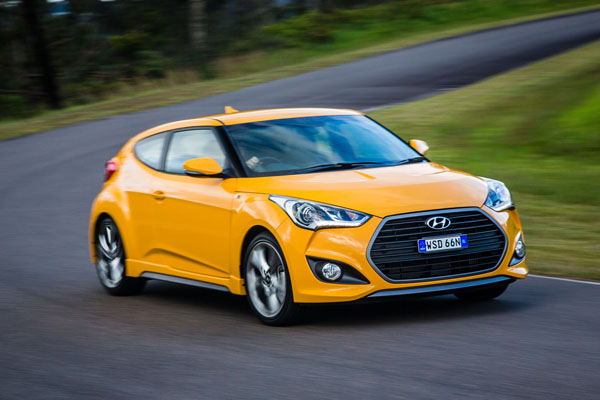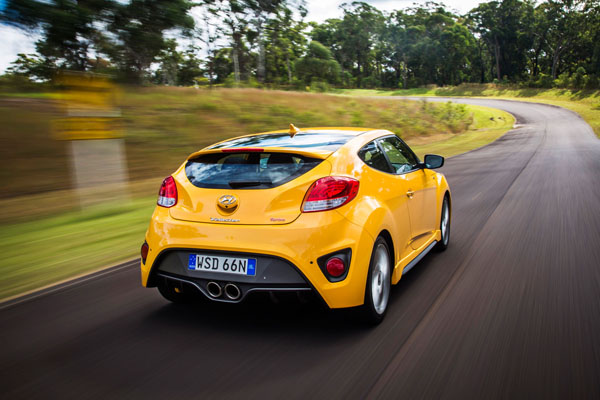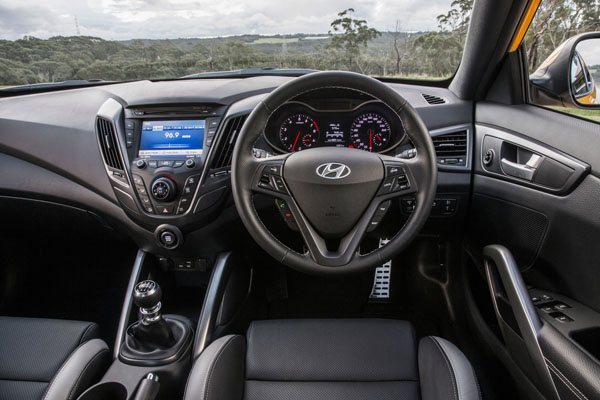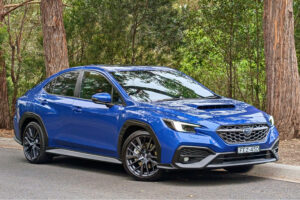It’s been a long time, but well worth the wait. When the Hyundai Veloster first came out, with its out-there looks and unusual architecture, it shaped up to be a challenger to the hot-hatch mob.
Unfortunately, somebody had forgotten about giving it the performance to match. The Veloster was held back by a naturally aspirated four-cylinder engine. Fortunately, we forgave shortcomings, much talk being of the sedan-cum-coupe styling, with two doors on the passenger side, only one on the driver’s side.
The result was the dismissal of the inconvenience of squeezing in and out of the back seats through a single entrance as in a conventional coupe.
It wasn’t until later when a turbocharger was hung off the motor that things began to heat up. I have had to wait until now and the Series II to taste the added grunt with a stint with a range-topping Veloster SR + Turbo, which comes to market at $36,490, plus on-road costs.
STYLING
Veloster Series II has taken on more of Hyundai’s Fluidic Sculpture styling with a distinctive grey grille surround and 18-inch alloy wheels in a choice of two new styles, both shod with sporty 225/40 R18 tyres.
However, the popularity of the Veloster seems to have dampened some of the car’s curiosity quotient. It was, in fact, the new unique Blue Sprinter matt paint finish of the test vehicle that ‘stole the show’.
INTERIOR
Taking up from the exterior, the test car cabin had blue highlights scattered all around, including the word ‘turbo’ on the sides of the front seat backs. No need for this, it’s a bit naff, really.
Contrasting stitching can be found on the steering wheel and coloured seatbelts are about to be installed with the newest models. Also new is an electroluminescent sports-style instrument cluster, while driver and front passenger are treated to power adjustable heated and ventilated seats.
The whole thing is topped off with a panoramic glass sunroof.
INFOTAINMENT
Up-to-date connectivity comes courtesy of a 7.0-inch LCD touchscreen displaying satellite navigation, CD player, MP3 input and three years HERE MapCare.
ENGINES / TRANSMISSIONS
Veloster Series II is powered by Hyundai’s direct-injection 1.6-litre Gamma engine, in naturally aspirated or turbocharged form. Power and torque figures for both engine types are unchanged. Turbo + power and torque are 150kW at 6000rpm and 265Nm between 1750 and 4500rpm.
Exclusive to the SR Turbo range is a smooth shifting seven-speed double clutch transmission with steering wheel-mounted paddle shifts.
The all-new seven-speed DCT offers fast changes and improved fuel economy, measured on the official test at 7.1 litres / 100 km, down from 7.6.
SAFETY
Six airbags – driver and front passenger, driver and front passenger side (thorax), full-length curtains – offer passive protection for occupants, while Electronic Stability Control including, Traction Control, Anti-lock Braking, Electronic Brake force Distribution, Brake Assist, Vehicle Stability Management aim to keep the car out of trouble in the first place.
Hill-start Assist Control, somewhat pointlessly offered with auto only, helps with setting off on steep inclines. A rear-view camera lets you keep track of obstacles when reversing.
DRIVING
After a slowish turbo take-up, the engine chimes in with a rorty note when urged with continued pedal pressure but the Veloster is short on the out-and-out exuberance of a true hot-hatch, even when using the paddle shifts.
Fuel consumption of the test vehicle was clocked at six litres per 100 kilometres in highway cruising but turned out a thirsty customer with up to 13 litres per 100 guzzled in the suburbs.
The Veloster SR + skipped along nicely, the wheels anchored firmly to the bitumen, even on the broken surfaces of some poorly maintained roads, thanks, no doubt, in no small part to the Aussie input of the suspension and steering tuning.
Veloster Series II has dumped the previous Veloster’s 16-bit Motor Driven Power Steering in favour of latest-tech 32-bit system. The SR Turbo + also adopts Hyundai’s driver-adjustable three-mode Flex Steer system.
SUMMING UP,
While not calling up the word ‘tepid’, the Veloster SR + fails to match performance with many of the so-called hot hatches of today. What it does have is looks to carry it off. And there’s the sub-30K turbo tag.
AT A GLANCE
MODEL LINE-UP
Veloster 1.6 GDi: $24,490 (manual), $26,990 (automatic)
Veloster + 1.6 GDi: $29,490 (manual), $31,990 (automatic)
Veloster SR 1.6 Turbo GDi: $29,990 (manual), $32,490 (automatic)
Veloster SR + 1.6 Turbo GDi: $33,990 (manual), $36,490 (automatic)
Note: These prices do not include dealer or government charges. Contact your local Hyundai dealer for drive-away prices.
AT A GLANCE
VELOSTER SR TURBO
Six airbags (driver and front passenger, driver and front passenger side (thorax), full-length curtains)
Electronic Stability Control including: Traction Control, Anti-lock Braking, Electronic Brake force Distribution, Brake Assist, Vehicle Stability Management
Hill-start Assist Control (DCT-equipped cars only)
Hyundai Active Locking Operation
Tyre Pressure Monitoring System
Projector-Beam headlamps
LED Daytime Running Lights
LED rear combination lights
Automatic dusk-sensing headlamps
7-inch LCD touchscreen with DivX, CD player and MP3 functionality
Premium audio system featuring 4 speakers, 2 tweeters, centre speaker, subwoofer and external amplifier
AUX/USB audio input with digital iPod compatibility
Bluetooth connectivity (hands-free phone and audio streaming)
Rear-view camera
Rear parking assist
Full body kit
18-inch alloy wheels with 225/40R18 tyres
Leather appointed seats
Premium steering wheel and gear knob
Front sports bucket seats
Proximity Smart Key with pushbutton start
Sports type Supervision cluster
Electric driver’s seat base slide and tilt
Electric lumbar support (driver’s seat)
Cruise control with steering wheel-mounted controls
Steering wheel-mounted audio and phone controls
Keyless entry with burglar alarm
Front and rear passenger-side power windows
One-touch window up/down on driver’s window incorporating anti-pinching safety feature
LED high mount stop light
LED side repeater integrated into side mirrors
Luggage net
VELOSTER SR + TURBO
7-inch LCD touchscreen Satellite Navigation with CD player, MP3 functionality and three years HERE MapCare
Panoramic glass sunroof
Climate-control air-conditioning with auto defog function
Ventilated and heated front seats
SPECIFICATIONS:
(1.6-litre four-cylinder turbocharged petrol engine)
Capacity: 1591 cc
Configuration: Transverse-mounted, direct injection, DOHC, 16-valve, four-cylinder
Bore and stroke: 77.0 mm x 85.44 mm
Compression ratio: 9.5:1
Maximum Power: 150 kW @ 6000 rpm
Maximum Torque: 265 Nm @ 1750-4500 rpm
DRIVELINE:
Drivetrain: Six-speed manual / Seven-Speed double clutch automatic transmission driving front wheels
DIMENSIONS, WEIGHT AND CAPACITIES:
Length: 4250 mm
Width: 1805 mm
Height: 1405 mm
Wheelbase: 2650 mm
Track: 1547 mm (front); 1560 mm (rear)
Ground clearance: 145 mm
Kerb weight: 1300-1360 kg
Gross vehicle mass: 1750 kg
Seating capacity: 5
Cargo capacity 440 litres
Fuel Tank Capacity: 50 litres
Turning circle: 10.4 m
SUSPENSION AND BRAKES:
Suspension: McPherson struts (front); coupled torsion beam axle (rear)
Brakes: Ventilated discs (front; solid discs (rear). ABS anti-skid brake system with electronic brake-force distribution, brake assist. Electronic stability management. Traction Control. Hill-start assist
Steering: Motor driven power assisted rack and pinion
Wheels / tyres: 18in x 7.5J alloy wheels with 225/40 R18 tyres. Temporary steel spare
PERFORMANCE
Acceleration 0 to 100 km/h: N/A
Top speed: N/A
FUEL CONSUMPTION:
Fuel type: 91 RON unleaded
Combined Cycle (ADR 81/01): 7.1 litres per 100 km. CO2 emissions 165 g / km
GREEN VEHICLE GUIDE RATINGS:
Greenhouse Rating: 7.0 / 10
Air Pollution Rating: 8.5 / 10
WARRANTY:
Five years / unlimited kilometres











